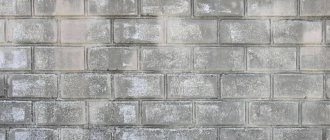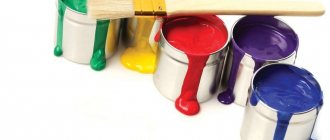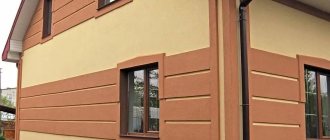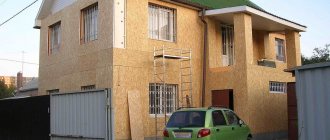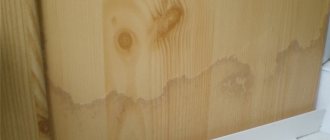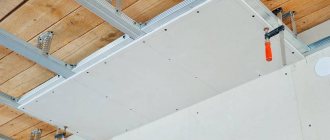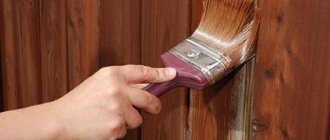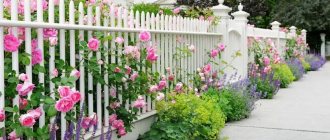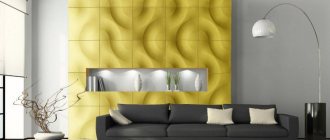Types of coatings
The stores offer a huge selection of paints, enamels and varnishes for wood. Each of them has its own pros and cons. Before purchasing, you should consider the main materials, compare them with each other, and only then decide what to paint the wooden fence with. Main types:
- Enamel. It has a low price, so you don’t have to save it and paint the fence in several layers. It looks beautiful and covers the wood with a thick protective film. But this paint is negatively affected by sunlight and temperature changes. The very next year, cracks will appear on the surface of the paint, through which moisture will penetrate. The fence will have to be painted every year.
- Oil paint. Relatively inexpensive, but not very aesthetically pleasing. Under open sunlight, it begins to swell and fall.
- Multicomponent compositions. They are distinguished by their high price, but they reliably protect the wood, thanks to the dense outer layer. Looks great and is weather resistant. The disadvantage of these paints is their high cost and toxicity. Therefore, it is not advisable to use them for painting inside the house or in the country.
- Acrylic paints. They are resistant to cold, heat, humidity and temperature changes. These properties last for a long time - for five years. Then you can simply touch up any problem areas that appear. The advantage of these paints is their low price and bright colors that do not fade under the sun.
- Varnish. Varnishing protects the wood and preserves its natural color. The varnish can be polyurethane, acrylic, dispersion and others. They protect wood in approximately the same way; you just have to take into account that acrylic varnish is less toxic than others.
Before painting, it is advisable to treat a wooden fence with an antiseptic impregnation. It is a colorless liquid that protects against moisture, rot, mold and parasites. Its validity period is up to 25 years.
There is also fire-prevention impregnation, which is often neglected in a country house or garden plot, saving money. The need for this impregnation becomes clear only during a fire.
Selecting the necessary tools
After deciding what paint to paint a wooden fence, you need to start selecting the right tools. There are 3 types used for painting:
- A brush is the most common tool that allows you to reach all hard-to-reach places and do the job efficiently. However, painting with a brush takes a lot of time and effort.
- A roller will significantly reduce painting time, but some places are inaccessible to it, so you can’t do without a brush.
- A spray gun allows you to quickly and efficiently paint a fence, but it requires additional equipment - a compressor.
When deciding what is best to paint a wooden fence: with a brush, roller or spray gun, do not forget about the tool that is necessary to prepare the surface for coating. During preparatory work, you may need the following work equipment:
- brush for sweeping away dust, dirt and cobwebs;
- sandpaper;
- putty knife;
- brush with metal bristles;
- wood putty.
Important! To paint a fence, you need to choose brushes made from natural hair. In cheap tools, artificial bristles constantly fall out, stick to the surface, interfere with work and spoil the aesthetic appearance.
Composition of wood paints
Choosing protective products for wooden fences
All wood paints, depending on the composition, are divided into covering (colored) and glazing (translucent). If the tree has a large number of flaws, they can be easily hidden using colored paints. However, under two or three layers of such paint, not only defects will be hidden, but also the unique texture of the wood.
Glazing paints contain pigments of various colors. Thanks to their translucency, the texture and beauty of the wood are clearly visible. In addition, such paints extend the service life of wooden products. In specialized stores you can buy:
- Pinotex Ultra. It is classified as glazing and contains colored pigments. It has antibacterial properties and covers the wood with a protective shiny film. One liter can paint 12 square meters of treated wooden surface.
- Toplazur "Belinka". Covers the wood with a silky layer and protects it from solar radiation. One liter of the composition stains 10 square meters of planed wood.
- Tikkurila Valtti Color. Has antibacterial and ultraviolet protection. Forms an even thin film on wood without hiding its texture. Using one liter of the composition, you can paint 10–12 square meters of treated boards.
- Holtz Azure Gel. A translucent product that protects wood for 8–10 years and is UV resistant. One liter of gel is enough to treat 10 square meters of wood.
When choosing paint for a wooden fence around a house or in a country house, you should keep in mind that its main task is to protect the wood from ultraviolet radiation. If you can’t buy the product for some reason, you can prepare it yourself. For example, cement, Swedish or Finnish.
How to paint a wooden fence
When choosing a coloring agent for a fence, each owner is guided by personal taste, the quality of the material, its characteristics and price. There are many different compounds on sale that will provide high-quality protection to colored hedges.
For coloring and preserving wood use:
- alkyd enamel;
- oil and acrylic paints;
- antiseptics.
Coatings that protect wood
Antiseptic solutions can be used to coat fences. These products are used to protect wood from mold and pests. The solutions evenly color the material and preserve its natural appearance. When working with antiseptics, you should remember that the products are very toxic and should not be allowed to come into contact with the skin and mucous membranes.
Before choosing a paint coating, you need to decide what result is needed. If the wood has numerous defects, then colored coatings will help hide them.
If you want to preserve the natural beauty of wood, translucent products are used; they are durable and, thanks to special pigments, have a wide range of colors.
Alkyd coatings
The composition of alkyd enamel includes various acids, polyhydric alcohols and other components that make this type of composition popular among buyers. After applying the alkyd agent, a thin film is formed on the surface of the wood, which improves the protective functions of the coating. The advantage of alkyd painting is also its good frost resistance.
But this coating has some disadvantages:
- under the influence of the sun, the color quickly fades;
- a year after painting, the coating begins to crack, water gets under it and the wood gradually rots;
- After applying alkyd enamel, wooden fencing often requires re-treatment.
To avoid peeling and blistering, alkyd enamel should be applied to a dry surface. Each layer of this coating must dry for at least 8 hours.
Acrylic paint for wooden fence
Acrylic-based paint for a wooden fence will protect the fence from external influences for at least 5 years. Such dyes are made on a water basis. If necessary, they can be used to process individual parts of the fence. Acrylic dyes can be mixed to create different shades.
This type of coating is environmentally friendly, but is not sufficiently resistant to mold and fungi. Before applying the acrylic product, more thorough preparation of the wooden surface is required. Depending on the number of layers applied, the service life of the coating increases.
Oil painting of wooden fences
After painting with oil paint, the wooden fence will be protected for a long time from temperature changes and precipitation. In addition, the oil base will prevent the spread of fungus on the wood. To obtain a high-quality coating, you will need to apply at least 2 layers of paint. Before processing, it is recommended to soak the boards with drying oil.
But it should be borne in mind that the oil base takes a long time to dry and has an unpleasant pungent odor. If renewal of the coating is required, the old paint will have to be removed.
Water-based paint
This type of paint can be used to treat a fence, but this coating will not last long. When painting with water-based emulsion, you must choose a warm season, otherwise the coating will be of poor quality, with traces of peeling.
To obtain a decorative effect, it is recommended to use alkyd enamel, which will delight you with its bright color for a long time. If the owner wants to preserve the natural texture of the wood, then you should pay attention to oil compositions.
Cement-based composition
To make a protective mixture for a wooden fence you will need cement.
Cement mixture is a cheap and high-quality material for wooden surfaces. It allows the wood to breathe, but does not protect well from moisture. The problem can be solved with the help of special additives. The cement composition is not in the direct sense of paint, however, the coating made from it is very effective.
To make it, you need to mix high-quality cement with water until the thickness of village milk, then add the selected dye. You will find it in the store. If you decide to use improvised material, then you need to do this carefully. Clay and cement can reduce the hardness of the coating. The ideal option would be to use grated brick.
The strength of the coating with this composition is explained by a special chemical reaction. The lime seems to be welded to the wood. This composition hardens quickly and therefore it is necessary to prepare small portions. They are used immediately. The problem can only be in the uniform color of the surface being painted.
How to coat (treat) a wooden fence against rotting and moisture for durability outdoors
Before erecting a fence at your dacha, you need to find out how to treat a wooden fence, for example, from rotting and moisture. There are several categories of compounds that can cope with the task. One of them is impregnation for a wooden fence.
Harmful effects on the fence
Wood is traditionally the most common construction and finishing material in Russia. Both the houses themselves and their fences are constructed from it. But this material is not resistant to many external influences.
Fence wood must be protected from the following negative factors:
- Exposure to harmful microorganisms. These are pathogenic fungi: blue, rust, green, black, white mold, as well as putrefactive bacteria. Their mycelia and colonies, growing, first change the color of the organic matter (it begins to turn black). And then rot eats it, turning it into dust. Harmful microorganisms appear due to excessive moisture in the wood. This environment is favorable for their reproduction.
- Life activity of harmful insects. Beetles - weevils, bark beetles, borers and others - destroy the tree, eating through many passages in it. Many types of insects are carriers of spores and bacteria, and therefore are capable of starting the process of decay.
- Climatic and weather conditions: wind, showers, temperature changes. In this case, wetting/drying and expansion/contraction of the material alternate. In the winter season, freezing of moistened wood is added to all this. It leads to rupture of cellulose fibers, the material begins to darken, crack and collapse. Sometimes moss appears on it.
- Solar ultraviolet radiation is also harmful to wood organic matter. It decomposes the lignin contained in it, which is a natural polymer. This substance structures the fibers, gives the wood hardness and tone. From prolonged exposure to direct sunlight, the fence fades and then acquires a grayish color. Organic matter becomes covered with numerous cracks, and its structure becomes loose. Only an opaque coating can preserve a wooden fence and protect it from ultraviolet radiation.
- Open fire. If there are buildings close to the fence, then it is advisable to cover it with fire protection. This is done by impregnation with a fire retardant.
Finnish paint
Iron ocher for making a Finnish mixture for painting wooden fences
During manufacturing, it is very important to strictly observe all proportions and technology. Take 6 liters of water, add 720 g of rye flour there and mix well. Then the mixture needs to be strained, put on fire and, stirring, add 360g of table salt. Iron sulfate and dry lime pigment are also added to the solution - 1560 g of each. Boil another 3 liters of water and pour into the resulting mixture.
The boards are painted with this composition twice, preferably on clean wood. If it was previously painted, the old paint must be removed. Finnish paint is breathable and durable. To give it an unusual color, you can add grated brick, decoctions of oak bark or sunflower seeds.
WHAT TO PAINT A FENCE: COATING OPTIONS WITH AN OVERVIEW OF CHARACTERISTICS
Wooden fences require mandatory painting, regardless of what material they are made of. It could be a rail, a picket fence, a board. The tree is in any case susceptible to the influence of precipitation and insect pests.
If a wooden fence is not painted, then moisture, temperature changes and insects will destroy the wood within a few years. The fence will lose its attractive appearance, the wood will swell, and putrefactive processes will begin. Protective coatings significantly extend the service life of fences. But it is very important to choose them correctly.
When choosing products for painting a fence, you should pay attention to the following characteristics:
1. High moisture resistance.
2. UV resistance.
3. Protection from bacteria and germs.
4. Color fastness: paint must last for at least 5 years.
Antiseptics
Before painting, it is recommended to treat the wood with an antiseptic. It protects against biological hazards. Antiseptic coating – colorless. It is necessary to cover it with varnish, paint or enamel on top.
Antiseptics you can use:
BioGuard Antiseptic for wood
· BioGuard Antiseptic, difficult to wash off
· BioGuard Antiseptic (CONCENTRATE)
To paint wooden fences, you can use acrylic, alkyd and polyurethane varnishes. They perfectly highlight the wood texture and protect the surface. Many users like the glossy lacquer finish.
Alkyd varnishes have a rather pungent odor and are toxic. But they are cheap and it is quite possible to work with them outdoors. So this is a good option for a fence.
Polyurethane varnishes are more expensive. They also have high toxicity. But they significantly extend the service life of wood. The appearance of the fence will be more presentable.
The most environmentally friendly and non-toxic are water-based acrylic varnishes. They are highly resistant to weather conditions and are quite durable.
For painting fences, we recommend choosing varnishes:
· DecoGuard High-strength polyurethane varnish
· DecoGuard Universal varnish
Impregnations
A decorative coating that emphasizes the wood texture can be created using decorative impregnations. They also protect the tree from all types of precipitation, UV rays, mold, algae and other pathological microflora.
Impregnations can be applied as a primer layer before varnishing. Thanks to impregnations, the strength and durability of the coating increases, and varnish consumption is reduced by 10-15%. The impregnations are odorless and dry quickly.
We recommend using:
· DecoGuard Protective and decorative impregnation with beeswax
· DecoGuard Impregnation-enamel to renew old wood
Acrylic paints and enamels
You can also purchase acrylic paints and enamels to paint the fence. The service life of such coating is at least 5 years. Water-based paint solutions are non-toxic, resistant to sunlight and precipitation. The coating retains its color for a long time. Another important advantage is the low price.
Before applying acrylic paints and enamels, the surface of the wood must be coated with a primer. This way the coating will retain its original color longer.
Acrylic paint is the most popular material. It can be used to cover any wooden surface. At the same time, the tree retains the ability to “breathe”.
Acrylic paints are also suitable for metal surfaces. If you have a mixed type fence: wood + metal, it will be enough to purchase one type of paint.
Advantages of acrylic paint:
· There are no smudges when painting.
· Surfaces become resistant to mechanical stress.
· The service life of wooden fences increases by several years.
· Metal fences are reliably protected from corrosion.
We recommend purchasing:
· PaintGuard Facade paint
· PaintGuard Enamel universal
Alkyd enamels
And one more option that can be recommended for wooden fences is alkyd enamel. This is an inexpensive coating with many positive characteristics:
· Penetrates deeply into the wood structure.
· Forms a waterproof film.
· Prevents moisture penetration.
· Resistant to temperature changes.
· Has antiseptic properties.
· Protects against mold and fungal infections.
Alkyd enamel should only be applied to dry wood surfaces, or it will peel off. Alkyd paints take a long time to dry and may lose color over time. But, thanks to the low price, these shortcomings do not seem significant.
If you have chosen alkyd enamel, we recommend purchasing:
· PaintGuard Enamel PF-115
How to paint a fence yourself
There are several ways, each of which can be done by anyone.
1. Painting by hand using a brush. The method is convenient because you can easily paint over hard-to-reach areas. Although the manual method is quite labor-intensive in terms of time.
2. Painting by hand using a roller. The method is suitable for painting large surfaces. Application is uniform, but paint consumption increases when applied with a roller. Some hard-to-reach areas are not painted over. You have to use a brush.
3. Painting with a spray gun. Paint application is uniform and consumption is economical. In terms of time, this method is faster than the previous two. But if you don’t have a spray bottle, you need to purchase one. And this also entails additional costs.
Swedish paint
Copper sulfate included in the coating for a wooden fence
To prepare the coating, combine 3 liters of water and 600 g of rye flour and place on fire. Stir continuously to avoid lumps. After obtaining a homogeneous mass, add salt and copper sulfate - 250 g each. When the crystals are completely dissolved, add 250g of red lead and mix well. At the end, add 250g of drying oil, mix again, and pour another 1.5 liters of water.
Use the prepared paint immediately, without allowing it to cool. As it cools, it thickens, and then you have to dilute it with water. This is undesirable, since the thinned paint layer will be less thin and durable. Swedish paint comes in red, brown or yellow. You can paint the fence with it once.
Do I need a primer before painting?
Applying primer before painting a wooden fence
Wood primer is a colorless liquid that acts as a protection for wood. It is capable of penetrating 5–7 mm into the depth of wood. The protective properties are imparted by the film formed on the surface of the wood.
During subsequent painting, the wood will practically not absorb paint, since its pores are already filled with primer. If the wood is pre-treated with primer, the consumption of varnish or paint is reduced by about 30 percent. Since paints and varnishes are much more expensive than primers, this results in significant savings.
But that's not the main thing. The primer contains substances that prevent pests from damaging the wood. It protects the wood from humidity, temperature changes, and prevents the appearance of mold.
Using a primer extends the service life of a decorative wood coating by an average of 5–7 years. This is especially important for wooden products that are located outdoors and are constantly exposed to frost, sun, rain, and insects. Therefore, before painting, it is advisable to treat the wood with primer.
Preparatory stage
Improved adhesion of materials to the wood surface is ensured by high-quality cleaning of the fence along its entire length. If the fence is old and needs updating, first remove the peeling paint. This can be done using a scraper, and the base must be rigid enough for such work.
Sanding the fencing structural elements will remove all minor irregularities. In this case, sandpaper is often used. This method is quite suitable for new and old fences. If the wood is heavily soiled (oil stains, dirt), you can use special compounds that help quickly remove stains.
One of the most effective is an alkaline remedy. To hide deep cracks, it is recommended to use putty. But these areas are first primed. Moreover, you should choose compositions intended specifically for this type of material.
Putty is performed in two stages. First, the wood is primed and large cracks are filled. Then the finishing layer of putty is applied. Coniferous wood has a large number of knots that need to be removed and varnished. Preparation and processing of the material can be done both before installing the fence and at the last stage. In any case, metal fasteners, for example, nail heads, must be coated with a primer with anti-corrosion properties.
General recommendations for painting a fence
The process of applying paint to wooden boards of a fencing structure
The installed fence at the dacha or around the house needs to be painted as soon as possible. Without proper treatment, the wood begins to rot and collapse. First, the wood is treated with impregnation. When it dries, apply a primer and then two coats of paint.
There are two ways to paint a fence – with a paint brush and a primer roller. When using a brush, more paint is consumed, but the quality of the work will be better. If you paint with a roller, less paint will be used, but there may still be places that will then have to be painted over with a brush.
Before painting, it is recommended to clean the fence from dust and dirt. If this is not done, flaws may remain after work. All cleaning, impregnation and painting work is carried out only in dry, warm weather.
In order for a fence to serve for a long time and maintain an attractive appearance, it needs care. “Health” procedures for him should be carried out at least once every two years. Then its service life will increase by 2-3 times.
How to paint a wooden fence correctly
It is recommended to apply paint on wooden fencing in calm weather. It is better not to carry out work in bright sunshine, as the paint will dry quickly, which will negatively affect the quality of the coating.
Painting is done from top to bottom. The composition is applied slowly and evenly, immediately eliminating all smudges. To prevent the brush from getting dirty on the ground when painting the bottom of the fence, you need to place a block under the boards. After applying the first layer, the coating must be given time to dry completely.
It is advisable to paint the fence before installing it in order to carefully process the ends of all elements.
If the fence will be in contact with the ground, then its lower part should be treated with a special product made on the basis of bitumen. After this procedure, the bottom of the fence receives water-repellent protection, which will increase the life of the fence.
Paint Application Tools
When choosing a tool for painting, preference should be given to brushes made from natural hair. When using a cheap tool, the bristles that fall out during the painting process will ruin the quality of the coating.
You can increase the painting speed by using a roller. For hard-to-reach places, telescopic handles are used, allowing the process to be performed at any height. A more even layer of paint without streaks is obtained after using a sprayer.
Preparing the surface for painting
Before applying a protective coating to wood, the surface should be prepared. Existing dirt and dust are removed from new wood. If the fence has already been painted, then remove the remnants of the old coating using a scraper or wire brush.
Wood has a rough surface, so in order for the paint to lay evenly, the fence is sanded using sandpaper. It also removes all protruding defects, oil stains and difficult to wash off dirt. Potholes and cracks should be filled with putty.
The process of painting a wooden fence
When painting a fence, you must follow the sequence of the procedure. After cleaning the fence, it is necessary to treat the wood with a primer. After it dries, they move on to puttying problem areas. Then the entire surface is sanded again and covered with finishing putty.
Following the technology, at the final stage we cover the surface with the selected product. Each subsequent layer is applied only after the previous one has completely dried. To protect the finishing layer, you can apply varnish on top.
